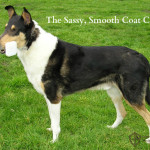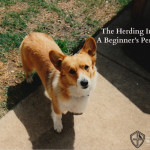Keeping It Clean
Coat Care for Long-Haired Herding Breed Dogs

Phoebe lives on a working Wisconsin farm with her family, Jesse and Leesa Schlimgen, and their boys, Levi and Lucas. Phoebe is a tri-colored Rough Collie who works alongside her owners to feed chickens, wrangle llamas and bring in the cows. But life on the farm has its grooming challenges. Along with her chores, Phoebe tangles with burrs, bits of hay, and cow yard goo.
“She’s gone out to the barn with Jesse after a heavy rain and come back in covered in mud,” Leesa said. “I have to wash her and use the llama dryer on her before she can come back into the house.”
So what does it take to keep a long coated herding dog presentable and healthy?
Cara Burgess is a professional groomer in Dallas, Texas and has regulars that include Bearded Collies, Rough Collies and Shetland Sheepdogs, along with shorter haired herding dogs like Australian Shepherds and the suddenly popular, American Shepherds. She says many owners come in wanting their long-haired dog shaved down. Of all grooming dos and don’ts, shaving long-haired herding dogs is one of the worst things that you can do.
“The coat on these breeds is meant to help regulate body temperature,” Cara explained. “When the hair is totally removed, including the outer coat, it makes it difficult for the dog to cool itself. Owners wanting Collies and Beardies to be shaved don’t understand that a dog panting on a hot day is normal, so long as the tongue is not curled.
“Dogs don’t perspire by sweating the way people do,” Cara said. ”They cool themselves through their paw pads, bellies, and ears—and by panting. Trimming the belly area and maybe removal of hair in the paw pads is all that is needed.”
According to long-time Collie breeder and pro-groomer Vickie VonSeggern, the coat on a long, double-coated herding breed should be straight with the outer coat harsh to the touch. Curly, wavy, or fuzzy coats are not correct and will be difficult to groom. A correctly textured coat allows the undercoat to shed out easily even when a female is spayed.
“You have to breed for this coat type in every generation and it is easy to lose it,” she said. “The same applies to smooth coated Collies; they should have a harsh and straight outer coat, not wavy or curly. It should be flat and lie close to the skin.”
Vickie advises first time Collie owners to schedule professional grooming for their dogs every six to eight weeks, with a good brush-out weekly - or more often if the dog is shedding.
“Most pet owners brush over the top of the fur without getting down to the skin,” Vickie explained. “I use Chris Christensen slickers and a V rake, along with a Mars Coat King in different sizes, to brush through the double coat. Some owners ask to have the leg feathering and side skirts trimmed up to make brushings easier between grooming visits.”
“Herding dogs do not get a “doggie odor” like sporting dogs,” she said. “They are not bred to be water dogs and don’t have an extra layer of oil at the skin to protect them from icy waters.”
Finding a groomer familiar with a long, double coat can be challenging. Most groomers today don’t see many Collies and often push owners shave the coat to the skin for easy keeping. To help new owners find groomers who understand the Collie coat, Vickie will identify prospective groomers close to the owner’s home and call to talk with them about grooming a double coated herding breed. During that conversation she stresses the importance of not shaving the dog and how doing so can negatively affect the dog’s health.
Both Vickie and Cara recommend making an appointment with the prospective shop before taking a dog in to be groomed. “Observe the shop and if it looks good, bring your puppy in to meet the staff,” Vickie said.
With the cost of grooming an adult, long-haired herding dog around $100 a visit, people will want to do what they can to keep their dog’s coat healthy between visits. Tools needed are
- a good quality slicker brush
- pin brushes
- short and long toothed rakes
- a spray bottle with water
Vickie especially likes the Chris Christensen tools (Mark III) and Cara recommends the Les Pooch brushes for de-matting and undercoat removal.
Puppies should be taught to be still while being groomed so owners can lift layers of hair while removing dead hair and any debris that might be tangled in the dog’s undercoat, rather than just brushing from the top—as many people do. Getting at that undercoat layer by layer is called line combing and is done by starting in one area of the coat where the hair is carefully parted and then brushed section by section. Applying a little moisture to the hair while brushing will help protect the shafts from being damaged during brushing.
Phoebe visits her groomer regularly and Leesa brushes her out between times—with the occasional as-needed bath at home. Good coat care helps to manage seasonal shedding and, barring misadventures in the barnyard, keeps Phoebe a healthy house dog as well as a working farm dog. It can be done.
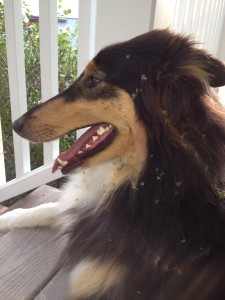
Phoebe Before Grooming
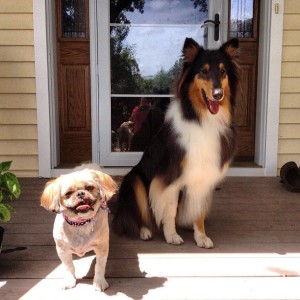
Phoebe After Grooming
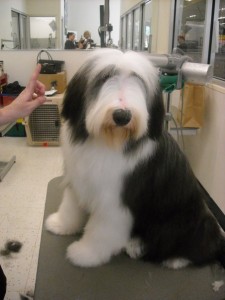
A Beardie Before Grooming
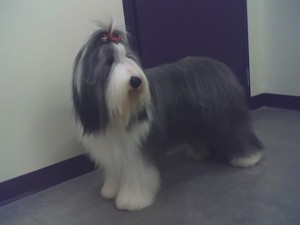
A Beardie After Grooming
Article By:
Bobbie Kolehouse




